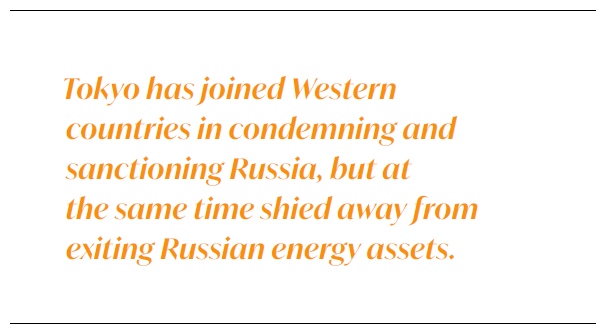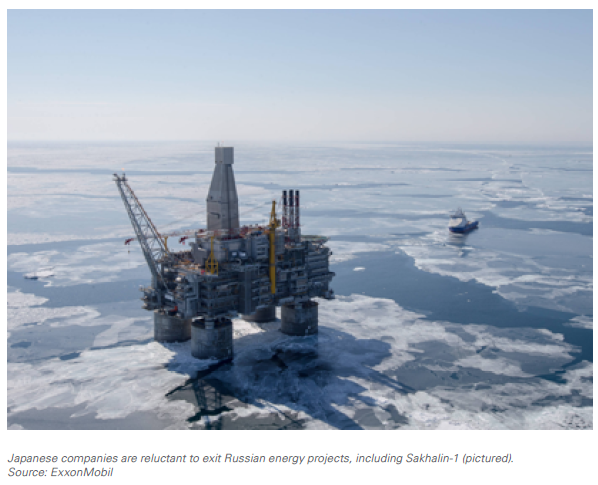Asian economies face shockwaves from Russia-Ukraine war [Gas in Transition]
The Russia-Ukraine war has sent shockwaves rippling through global commodity markets, putting emerging Asian economies with large oil and gas imports most at risk as they come under strain from substantially higher energy prices and volatility.
Most countries in Asia-Pacific have little direct exposure to Russia or Ukraine in terms of energy supplies or investments, as the bulk of Russian gas exports remain in Europe with Germany, Italy and Turkey the largest recipients. Nevertheless, Asia’s largest economies – China, Japan, South Korea and India – all source some of their gas needs from Russia, while numerous countries in the region are significant net energy importers.
China is most exposed to Russia, receiving some 12% of its total fuel imports from its northern neighbour. South Korea ranks next on 9%, while Japanese, Singaporean and Vietnamese dependency on Russian energy is in the mid-to-low single digits.
As the largest gas importers in Asia-Pacific, China, Japan, South Korea and India use an array of suppliers to reduce dependence risk and exposure to unforeseen events such as geopolitical flare-ups and natural disasters. For instance China – the world’s biggest LNG buyer last year – received most of its supplies from Australia, but it also has substantial long-term contracts with Qatar, Malaysia, Russia and the US. Other countries are similarly diversified.
But indirect consequences flowing from the fast-moving conflict will still be meaningful for Asia’s economies. The knock-on effect has been an acceleration of energy and commodity price inflation, with Brent prices well above $100 per barrel and still extremely volatile. Gas prices have not escaped unscathed either, with benchmarks in Europe and Asia soaring to all-time peaks.
The oil and gas price surge has left Asian LNG importers in a vulnerable position. Although there are other large global LNG producers that could reroute supplies, it would take time to build infrastructure and increase liquefaction capacity. In the meantime, global supplies will stay tight.
Europe’s plan to boost LNG imports will come at the cost of demand destruction in the emerging world. The biggest losers are poised to be nations in South Asia, like Pakistan and Bangladesh that are much more price sensitive and are unable to procure spot supply at current rates.
At the same time Europe is likely to look to Asia to bridge any potential energy supply gap from decreased Russian imports. The result will be higher revenues for many countries in South and Southeast Asia that own state-backed hydrocarbon exporters, such as Malaysia’s Petronas, Pertamina from Indonesia, and Thailand’s PTT.
At the same time, many of these NOCs operate integrated and diversified business models. This means the gains from selling oil and gas at a higher price will be partly offset by higher costs at the downstream operations of these NOCs, with refining activities and subsidised fuel distribution most likely to suffer.
The upshot for Asia’s energy scene is that there will be winners and losers from Russia’s attack. Surging oil and gas prices will split the region into those nations that export fossil fuels, and those that rely heavily on energy imports.
Higher energy prices could trigger an economic shock for the largest net importers in Asia-Pacific – India, the Philippines, South Korea, Taiwan, and Thailand – by hitting their current account balances and real domestic consumption and investment. The prices would be a plus for the region’s net energy exporters, particularly Indonesia, Malaysia and Australia.
China leans on coal, avoids discussion
China has responded to the surge in global gas prices by slashing gas imports and substantially increasing production and imports of coal, the most polluting fossil fuel. Combined inflows of piped gas and seaborne LNG in the first two months of 2022 dipped by 3.8% year/year to 19.86mn metric tons, according to official customs figures.
Meanwhile, domestic coal production has reached a record high, marking a reversal of the coal-to-gas switching that has supported Chinese gas demand since 2015. China’s coal output reached an all-time high of 4.07bn mt last year and central authorities pledged in early March to keep daily production at record highs of more than 12mn mt.
The switchback from gas to coal is understandable given the current pricing differential between the two energy sources, but it is also unsustainable given China’s climate goals. Even with the rapid increase in coal production, Chinese coal inventories have been on a downward trend resulting in record prices. As such it seems unlikely that coal prices will fall substantially in the short term as China uses coal to make up for a shortfall in gas supply..png)
Beijing has so tiptoed around discussion of how the war will affect domestic energy security and the economy, with the conflict and its snowballing repercussions conspicuously absent from the Chinese government’s annual work report published in early March.
But the effect is beginning to show up in economic data. China’s producer price index (PPI) – which reflects the prices that factories charge wholesalers – climbed by a higher-than-expected 8.8% in February from January. The month-on-month increase was down to “the increased commodity prices globally such as crude oil and nonferrous metals”, statistics officials have acknowledged.
For China, Russia is an important energy source – last year Beijing sourced 15.5% of its crude oil imports, 15% of coal purchases, and 10% of total gas and LNG volumes from Russia last year, according to customs data.
While fallout from the conflict is unlikely to hurt China’s economy to the same extent as some European countries, it will still be affected by the ripple effect of surging energy and commodity prices to some extent. This presents an upward risk in inflation, as underlined by February’s higher PPI.
Sanctions-driven disruptions to the global supply chain would also impose challenges for Chinese manufacturers. All of this will be unwelcomed in Beijing as it is coming at a time when China is facing mounting economic downward pressure.
Looking further ahead, the invasion and its aftermath will have a profound impact on China’s short-term energy supplies, its policy priorities for the coming year and long-term energy policies.
Chinese national oil companies CNPC and Sinopec are said to be considering buying or increasing stakes in Russian energy and commodities companies such as Gazprom, and Moscow’s growing international isolation could also lead it to offer attractively priced gas pipeline deals to Beijing and open up new investment opportunities for Chinese firms in Russia’s energy sector. .png)
It is an equally complex situation for Japan, the world’s fourth-largest crude importer. Tokyo has joined Western countries in condemning and sanctioning Russia, but at the same time shied away from exiting Russian energy assets.
Asia responds to mounting pressure
Barring a drastic change in the Russia-Ukraine situation – such as a wider war in Europe – the likelihood is that Japanese companies will hold onto their stakes in the Sakhalin-1, Sakhalin-2 and Arctic LNG-2 projects. The first two projects are key suppliers to Japan, given their close proximity, and the third, Arctic LNG-2, will also serve the Japanese market once it is up and running in 2023.
Tokyo also fears that Japanese companies exiting their Russian investments will simply be replaced by rivals from countries like China. Japan must protect its energy security “as much as possible” as it responds to Russia, trade minister Koichi Hagiuda said in early March.
Tokyo is among a number of Asian governments that have taken measures to soften the impact of escalating oil and LNG prices on their economies. Japan lifted the cap on subsidies for gasoline, diesel and kerosene from the current 5 yen ($0.04)/litre to 25 yen/l.
 In January, Japanese authorities introduced temporary subsidies of up to 5 yen/l if retail gasoline prices exceed 170 yen/l – making Japan possibly the only developed economy to provide direct fuel subsidies, despite joining a pledge at the COP26 climate summit last November to end “inefficient fossil fuel subsidies”. The government said it will take 350bn yen from this fiscal year’s emergency budget reserves to fund the subsidy.
In January, Japanese authorities introduced temporary subsidies of up to 5 yen/l if retail gasoline prices exceed 170 yen/l – making Japan possibly the only developed economy to provide direct fuel subsidies, despite joining a pledge at the COP26 climate summit last November to end “inefficient fossil fuel subsidies”. The government said it will take 350bn yen from this fiscal year’s emergency budget reserves to fund the subsidy.
Facing a similar situation, the government of South Korea in early March extended a 20% tax cut on gasoline, diesel and LPG by three months. The tax cut, introduced in November, was originally due to expire at the end of April. Finance minister Hong Nam-ki said his ministry is considering a possible increase in the tax cut, given that prices have risen even higher since its introduction.
Seoul will also continue to exempt LNG from import tariffs for another three months until the end of July. South Korea usually imposes a 2% tariff on LNG imports during the winter months and 3% in other months.
Among Southeast Asian countries, Russia has invested the most in Vietnam as Hanoi has longer-standing diplomatic ties with Moscow than with any other government. Economic ties between the two countries are mainly confined to energy-related trade and investment, while ties with Ukraine are not economically significant.
There is little prospect of Russia successfully pushing Vietnam to support its cause, but Vietnam’s government has so far taken a line similar to China on Russia’s invasion of Ukraine, refraining from condemnation and advocating a resolution through diplomacy.
Russia is a major investor in energy infrastructure in Vietnam, including offshore oil and gas fields, pipelines and terminals. However, most of its investments are restricted by law to minority stakes. This would limit any destabilising effect from voluntary or forced divestment of these assets, although Hanoi would be very averse to such an outcome.
Vietnam’s main imports from Russia are coal and oil, though Russia accounts for a small share of total inbound coal shipments and an even smaller proportion of oil imports. Like other Asian energy importers, Vietnam is facing the prospect of higher global oil prices that could feed into the cost of the country’s maiden LNG imports expected later this year.



